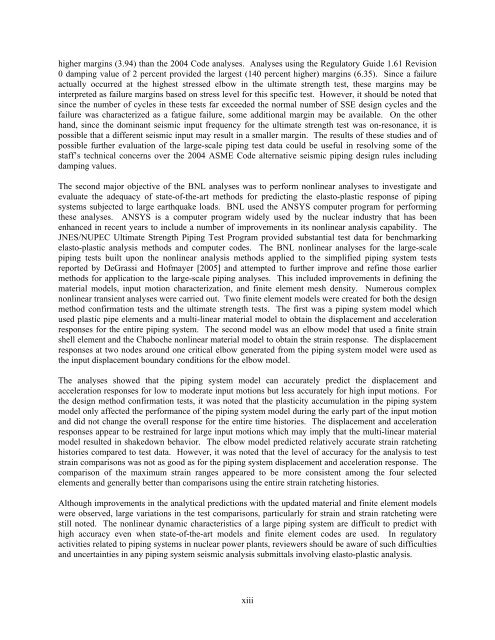Seismic Analysis of Large-Scale Piping Systems for the JNES ... - NRC
Seismic Analysis of Large-Scale Piping Systems for the JNES ... - NRC
Seismic Analysis of Large-Scale Piping Systems for the JNES ... - NRC
Create successful ePaper yourself
Turn your PDF publications into a flip-book with our unique Google optimized e-Paper software.
higher margins (3.94) than <strong>the</strong> 2004 Code analyses. Analyses using <strong>the</strong> Regulatory Guide 1.61 Revision<br />
0 damping value <strong>of</strong> 2 percent provided <strong>the</strong> largest (140 percent higher) margins (6.35). Since a failure<br />
actually occurred at <strong>the</strong> highest stressed elbow in <strong>the</strong> ultimate strength test, <strong>the</strong>se margins may be<br />
interpreted as failure margins based on stress level <strong>for</strong> this specific test. However, it should be noted that<br />
since <strong>the</strong> number <strong>of</strong> cycles in <strong>the</strong>se tests far exceeded <strong>the</strong> normal number <strong>of</strong> SSE design cycles and <strong>the</strong><br />
failure was characterized as a fatigue failure, some additional margin may be available. On <strong>the</strong> o<strong>the</strong>r<br />
hand, since <strong>the</strong> dominant seismic input frequency <strong>for</strong> <strong>the</strong> ultimate strength test was on-resonance, it is<br />
possible that a different seismic input may result in a smaller margin. The results <strong>of</strong> <strong>the</strong>se studies and <strong>of</strong><br />
possible fur<strong>the</strong>r evaluation <strong>of</strong> <strong>the</strong> large-scale piping test data could be useful in resolving some <strong>of</strong> <strong>the</strong><br />
staff’s technical concerns over <strong>the</strong> 2004 ASME Code alternative seismic piping design rules including<br />
damping values.<br />
The second major objective <strong>of</strong> <strong>the</strong> BNL analyses was to per<strong>for</strong>m nonlinear analyses to investigate and<br />
evaluate <strong>the</strong> adequacy <strong>of</strong> state-<strong>of</strong>-<strong>the</strong>-art methods <strong>for</strong> predicting <strong>the</strong> elasto-plastic response <strong>of</strong> piping<br />
systems subjected to large earthquake loads. BNL used <strong>the</strong> ANSYS computer program <strong>for</strong> per<strong>for</strong>ming<br />
<strong>the</strong>se analyses. ANSYS is a computer program widely used by <strong>the</strong> nuclear industry that has been<br />
enhanced in recent years to include a number <strong>of</strong> improvements in its nonlinear analysis capability. The<br />
<strong>JNES</strong>/NUPEC Ultimate Strength <strong>Piping</strong> Test Program provided substantial test data <strong>for</strong> benchmarking<br />
elasto-plastic analysis methods and computer codes. The BNL nonlinear analyses <strong>for</strong> <strong>the</strong> large-scale<br />
piping tests built upon <strong>the</strong> nonlinear analysis methods applied to <strong>the</strong> simplified piping system tests<br />
reported by DeGrassi and H<strong>of</strong>mayer [2005] and attempted to fur<strong>the</strong>r improve and refine those earlier<br />
methods <strong>for</strong> application to <strong>the</strong> large-scale piping analyses. This included improvements in defining <strong>the</strong><br />
material models, input motion characterization, and finite element mesh density. Numerous complex<br />
nonlinear transient analyses were carried out. Two finite element models were created <strong>for</strong> both <strong>the</strong> design<br />
method confirmation tests and <strong>the</strong> ultimate strength tests. The first was a piping system model which<br />
used plastic pipe elements and a multi-linear material model to obtain <strong>the</strong> displacement and acceleration<br />
responses <strong>for</strong> <strong>the</strong> entire piping system. The second model was an elbow model that used a finite strain<br />
shell element and <strong>the</strong> Chaboche nonlinear material model to obtain <strong>the</strong> strain response. The displacement<br />
responses at two nodes around one critical elbow generated from <strong>the</strong> piping system model were used as<br />
<strong>the</strong> input displacement boundary conditions <strong>for</strong> <strong>the</strong> elbow model.<br />
The analyses showed that <strong>the</strong> piping system model can accurately predict <strong>the</strong> displacement and<br />
acceleration responses <strong>for</strong> low to moderate input motions but less accurately <strong>for</strong> high input motions. For<br />
<strong>the</strong> design method confirmation tests, it was noted that <strong>the</strong> plasticity accumulation in <strong>the</strong> piping system<br />
model only affected <strong>the</strong> per<strong>for</strong>mance <strong>of</strong> <strong>the</strong> piping system model during <strong>the</strong> early part <strong>of</strong> <strong>the</strong> input motion<br />
and did not change <strong>the</strong> overall response <strong>for</strong> <strong>the</strong> entire time histories. The displacement and acceleration<br />
responses appear to be restrained <strong>for</strong> large input motions which may imply that <strong>the</strong> multi-linear material<br />
model resulted in shakedown behavior. The elbow model predicted relatively accurate strain ratcheting<br />
histories compared to test data. However, it was noted that <strong>the</strong> level <strong>of</strong> accuracy <strong>for</strong> <strong>the</strong> analysis to test<br />
strain comparisons was not as good as <strong>for</strong> <strong>the</strong> piping system displacement and acceleration response. The<br />
comparison <strong>of</strong> <strong>the</strong> maximum strain ranges appeared to be more consistent among <strong>the</strong> four selected<br />
elements and generally better than comparisons using <strong>the</strong> entire strain ratcheting histories.<br />
Although improvements in <strong>the</strong> analytical predictions with <strong>the</strong> updated material and finite element models<br />
were observed, large variations in <strong>the</strong> test comparisons, particularly <strong>for</strong> strain and strain ratcheting were<br />
still noted. The nonlinear dynamic characteristics <strong>of</strong> a large piping system are difficult to predict with<br />
high accuracy even when state-<strong>of</strong>-<strong>the</strong>-art models and finite element codes are used. In regulatory<br />
activities related to piping systems in nuclear power plants, reviewers should be aware <strong>of</strong> such difficulties<br />
and uncertainties in any piping system seismic analysis submittals involving elasto-plastic analysis.<br />
xiii
















